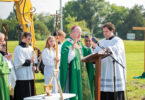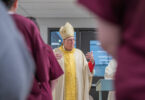
by Jill Ragar Esfeld
jill.esfeld@theleaven.org
LENEXA — To this day, Holy Trinity, Lenexa, parishioner Sheila Berry remembers running down a hill after her little brother Rob, catching him by the shirttail just before he fell into a bottomless well.
Her mother came running up behind her, screaming.
Had her brother fallen in, he surely would have died.
Berry’s mother, Esther White, attributed his survival to the intercession of St. Rose Philippine Duchesne.
It is one of many miracles the saint has brought to the doorstep of this family.
Holy Land
This particular miracle took place because Berry’s father, Bob White, had recruited his children to help him search for proof of a tale he remembered hearing when he was growing up in Sacred Heart Parish in Mound City.
“My dad loved history,” Berry recalled. “He remembered the old-timers talking about a nun and the Potawatomi Indians — and that they lived not far from there.”
The old-timers were referring to St. Rose Philippine, who came on mission from France in 1818 to the Sacred Heart community in New Orleans and then St. Charles, Missouri.
Twenty years later, she would come to Kansas to help the Potawatomi Nation. Forced off their land in Indiana, the Potawatomi were marched 660 miles to the Catholic Sugar Creek Mission in Linn County, Kansas.
The journey would be known as the Trail of Death.
Saint Rose Philippine spent a year in Sugar Creek ministering to the Native Americans and helping build a school.
When the Potawatomi were relocated in 1848, the mission was burned down and forgotten.
But the day of their outing, the White family found proof of its location in arrowheads and shards of pottery littering the ground.
And, of course, the well.
Later, with the help of a metal detector, they found pieces of rosaries buried in the earth.
Esther White was so moved by her son being saved from sure tragedy, that she felt it was a sign from God.
“We’ve got to do something about this land,” she told her husband.
From mission to memorial
And so, Bob White, along with Father Robert Pool, pastor of Sacred Heart at the time, headed a committee to purchase the land.
“Dad had a vision and followed through with the help of a lot of other people who saw that there was something very special about the place,” said Berry.
In 1982, with the help of the local Knights of Columbus, White began to work from blueprints to establish landmarks for the original mission.
In July 1988, when St. Rose Philippine was canonized, the park took on the even more important purpose of being a memorial to a saint.
White would do much of the work himself, building Stations of the Cross for a meditative walk and erecting crosses bearing the names of the 600 Potawatomi Catholics who died there.
“He found people to do the [station] paintings,” said Berry. “He would get the wood for the signage and Rob did all the engraving in the basement of the White Haven.”
White Haven Motor Lodge in Overland Park was owned and run by the White family.
Berry remembers her father working at the park into the night.
“He would go down there several days a week and work all by himself,” she said. “We would say, ‘Dad, please be careful,’ and he would say, ‘Saint Philippine will take care of me.’
“Then he would add, ‘Now if I don’t come back by 6 [o’clock], come looking for me!’”
Duchesne descendants
Many descendants from the Duchesne family were able to attend the canonization of St. Philippine in Rome. Subsequently, they formed the Perier Association — Jacques Perier was the saint’s grandfather.
In 1990, a group from the association made a pilgrimage to the United States tracing the journey of their ancestor here.
As part of the pilgrimage, they toured the Sugar Creek Mission and were hosted by the White family at the White Haven.
“It was so awesome, then,” recalled Berry. “My mom and dad were in such good shape. We did lunch at their house and dinner was here (at Berry’s home).
“We all worked together trying to take care of the White Haven and the French at the same time.”
Nicolas Derely, current president of the Perier Association, remembered his parents going on the pilgrimage and telling stories about the White family’s generosity and deep Catholic faith.
This year, the bicentennial of St. Rose Philippine’s arrival in the United States, he decided to organize another pilgrimage.
“We have 69 people on our association mailing list,” he said. “So, it is very easy to organize a journey like this one.”
Derely contacted Pierre Oury, a Perierdescendant living in Washington, who then got in touch with Berry.
Though the White Haven has since closed and Berry has suffered the loss of both her parents and her brother Mark, she and Rob were eager to uphold the White family’s reputation for hospitality.
In the end, 30 pilgrims came from France to follow in St. Rose Philippine’s footsteps in New Orleans, Kansas and St. Charles.
Berry agreed to welcome the pilgrims on the Kansas leg of the trip.
With the help of Oury and her brother, she arranged what the pilgrims later called the best part of their pilgrimage.
The itinerary
The French group spent their first morning at the monastery of the Little Sisters and Brothers of the Lamb.
The Community of the Lamb is based in France, so the pilgrims were able to pray and sing in their own language.
The Little Sisters, who prayed to St. Rose Philippine when they were establishing a community in Kansas, put on a play in French reenacting the saint’s original journey.
The pilgrims went from there to Mass at St. Philippine Duchesne Church in Westwood, and spent the afternoon at the Nelson-Atkins Museum of Art in Kansas City, Missouri.
That evening, they were treated to a barbecue hosted by the White family at Berry’s home.
The following morning, the group attended Mass and a luncheon at Sacred Heart Church in Mound City.
Pastor Father Barry Clayton welcomed them, recalling that St. Rose Philippine was known in this area as “the woman who prays always.”
“The family of Saint Philippine carries that legacy with you,” he said. “She is an inspiration to you and an inspiration to us here who know her as a saint.
“We try to imitate her dedication to God and her life of prayer.”
The pilgrims also met and visited with members of the Prairie Band Potawatomi Nation.
“I’m very proud of being a Potawatomi,” Jerry Tuckwin told the visitors. “But in my heart, I’m very proud to be a Catholic as well.
“I went to the canonization of St. Rose; many Potawatomi were there, and it was the highlight of our lives.”
A final journey
The Native Americans then accompanied the French on their visit to St. Philippine Duchesne Memorial Park.
At a monument displaying the route of the Trail of Death, tribal chairman Zeke Rupnick explained to the pilgrims that “we have ancestors buried all along that way.”
The pilgrims were able to walk the path of the Potawatomi in Sugar Creek Mission and stand in the ravine where they sheltered during the first brutal winter there.
“It’s a beautiful place; it’s a serene place,” said Berry. “And what I explained to them is it’s left the same as when Saint Philippine was there.
“And you can feel the presence. I always have. You can picture what they must have gone through.”
The pilgrims took turns sitting on the rock where St. Philippine prayed her rosary. They then walked the Stations of the Cross built by Bob White.
They studied the tall crosses inscribed with the names of the Potawatomi buried there, in what proved to be an emotional experience.
And they ended their journey gathered around the memorial, reading poems the Potawatomi had written about St. Rose Philippine, first in French and then in English.
Finally, they prayed together at the site of their ancestor’s last mission.
“It was a glorious day,” said Berry. “The good Lord really shone down on us. It was all so God divined.”







[…] Kansan named Bob White remembered his father talking about a nun and the Potawatomi Indians who lived nearby. Many others […]
Thank you Jill for this wonderful article. It was a pleasure to have you with us during the Kansas portion of our pilgrimage. Your pictures were marvelous!